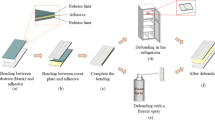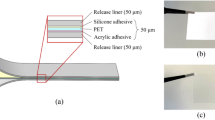Abstract
Microchip components may involve different polymeric materials for integrated functions, and the thermal bonding of heterogeneous materials is a challenge. This study is devoted to the bonding of polycarbonate (PC) and polymethacrylate (PMMA) materials. For conventional thermal bonding of PC and PMMA, the temperature must be above 150 °C. CO2 is used as a plasticizer to lower the bonding temperature to 90 °C. CO2 also serves as a pressurizing agent to provide uniform bonding pressure. To further improve the bonding strength, surface nano-pillar structures are fabricated on PC before binding it with PMMA. Because of the nano-pillar structures, the contact areas significantly increased, and the structural inter-lock further increased the strength after bonding thereby yielding a bonding strength of 1.20 MPa.
Similar content being viewed by others
Explore related subjects
Discover the latest articles, news and stories from top researchers in related subjects.Avoid common mistakes on your manuscript.
1 Introduction
A variety of measurements based on optical or thermal properties of fluids have been developed in for microfluidics devices and biosensors. Plastics are essential materials for these components (Ng et al. 2008). Usually, to make a product, manufacturing uses different plastic materials that have different properties, which in turn renders the final product with characteristic properties of all the materials used. For example, the main body may need polycarbonate (PC) for high strength, while the cover may use polymethacrylate (PMMA) for better transparency. Bonding of these components is a critical manufacturing process. Many approaches have been developed for binding of polymer materials, using adhesives the most popular. However, adhesives or liquid solvent may induce residue and block the channels inside the product. In certain situations, thermal fusion bonding is preferred. Thermal fusion bonding utilizes heat energy to activate the polymer molecules. Under embossing pressure, molecules of different polymeric components bond together (Fiorini et al. 2003). However, the materials must be heated up to their glass transition temperature (Tg) in a thermal bonding. The high embossing temperature may induce residual stress and prolong the cycle time. Moreover, high temperature usually deform the shape of the product, and such a side effect is unexpected.
Carbon dioxide (CO2) can be used as an effective gas solvent for some polymer materials such as PMMA and PC, leaving no residue (Liu 2001). It can be used to lower the bonding temperature. Previous research (Wu et al. 2012) has demonstrated that using CO2-assisted thermal fusion bonding process, two PMMA plates can be bonded at 80 °C, which is much lower than the Tg of PMMA material. CO2-assisted thermal fusion bonding process is also used to bind PC and PMMA, because the bonding involves heterogeneous materials, the bonding strength is low, as shown in Fig. 1.
To guarantee seal-tightness, a bonding strength of at least 1 MPa is usually required (Tsao and DeVoe 2009). To enhance bonding strength in CO2-assisted thermal fusion bonding process, nano-pillars are fabricated on the PC surface before bonding with PMMA. With the aid of nano-pillar structures, the contact areas in the bonding of PC/PMMA are increased, and structural inter-lock further enhances the bonding strength. A schematic of nanopillar-enhanced CO2-assisted thermal fusion bonding process is shown in Fig. 2.
For fabrication of nano-pillar arrays, an anodic aluminum oxide (AAO) template is used as the master mold. Usually the surface nanostructures are replicated from a master mold. There are different methods for fabricating a master mold with nanostructures such as electron beam and reactive ion etching (RIE). These methods use high-energy density beams for direct-write nanostructure fabrication. In addition, they are expensive, time-consuming, and of limited area. AAO is an efficient and cost-effective process for manufacturing nanostructures arrays (Wang and Han 2003; Masuda et al. 1997). The AAO templates with periodic porous nanostructures can be easily fabricated using two-step anodization process, as shown in Fig. 3. The nano-pillar array is fabricated by pressing the heated PC plate into the AAO master mold. Gas-assisted hot-embossing process is then employed to fabricate the nano-structure on PC.
2 Experiments
2.1 Preparation of anodic aluminum oxide master mold
Figure 4 shows the equipment used for fabrication of the AAO master mold. An aluminum sheet of high purity (99.7 %) was cleaned and annealed at 580 °C for 1 h. The aluminum sheet was placed in a bath of electropolishing solution of perchloric acid (HClO4, 70 wt%) and ethyl alcohol (C2H5OH, 99.5 wt%) with the volume ratio of 1:4. The aluminum sheet was electropolished for 10 min under a constant voltage of 20 V at 32 °C. This aluminum sheet was then anodized under constant voltage of 80 V in 0.1 M oxalic acid (H2C2O4, 99 wt%) at 4 °C for 5 h. Since the orientation of the nano-pores in the anodic oxide layer was not sufficiently regular, the layer was removed by phosphoric acid (6 wt%) at 32 °C for 3 h.
Another anodization step was performed with the same settings as the first, except that the time was shortened to 10 min. Finally, the aluminum with anodic oxide layer, which consisted of a highly ordered nano-pore arrays, was immersed in phosphoric acid solution (6 wt%) for 24 min at 32 °C to widen the diameter of the nano-pores.
2.2 Fabrication of nano-pillar array in PC sheet
The nano-pillars were fabricated on a PC sheet surface by pressing the heated and softened PC into the nano-pores of the AAO master mold. Pressurized gas was used to provide uniform embossing pressure. Figure 5 shows the steps of gas-assisted hot-embossing process (Chang and Yang 2003). First, the master mold and substrate (PC) were brought in contact to form a stack on the hot plate, which is the bottom surface of the chamber. After the stack is covered with a PET seal film, the chamber is tightly closed, enclosing the space. After heating the stack to a specified temperature, pressurized N2 gas was injected to pressurize the stack. The heated and softened PC was then pressed into nano-pores of the AAO master mold; the nano-pillars were fabricated on the PC sheet surface.
2.3 CO2-assisted thermal fusion bonding process
The PC sheet with nano-pillar structures on its surface was bonded to a plain PMMA sheet. CO2-assisted thermal fusion bonding process, as illustrated in Fig. 6, was employed. The PC and PMMA substrates were first brought in contact to form a stack and placed in the lower chamber, which is covered by a PET seal film. The upper chamber is subsequently covered to form a tightly enclosed space with two sub-spaces separated by the seal film. The stack is heated to 80 °C and soaked in high pressure CO2 for a time period. At the same time, a pressure difference between the upper and lower chambers, which comes from controlling the individual pressure in each chamber, was maintain to compress the stack, thereby inducing bonding of the PC and PMMA. The pressures in both chambers were released during the decompression stage. During the subsequent isothermal packing stage, a small pressure is maintained in the upper chamber to ensure that the bonded plates remain flat, after cooling, the bonding completes. The temperature, pressure (in the lower chamber), and the pressure difference (between the upper and lower chambers) are shown in Fig. 7. The processing parameters used are shown in Table 1. To obtain the best processing parameters, the following were used: process temperatures, 80 and 90 °C; CO2 soaking pressures, 3 and 4 MPa; and soaking time, 15 or 20 min.
The bonding strength can be calculated from the maximum allowed shearing force measured by a material testing machine (Insight 10KN, MTS) (Ng et al. 2008; Studer et al. 2002). The bonding strength can be obtained by dividing the maximum recorded shearing force by the overlap area. The sample dimensions and bonding area are shown in Fig. 8.
3 Results and discussion
Figure 9 shows the nano-pillars fabricated on the PC sheet surface as observed under a scanning electron microscope (SEM), at an approximate pitch and a diameter of 300 and 220 nm, respectively.
Figure 10 shows the bonding strengths of PMMAs and PCs with and without nanostructures. The thermally fused PC/PMMA at 90 °C, after being soaked in CO2 of 40 kgf/cm2 for 15 min, yielded the highest bonding strength, close to 1.2 MPa. Because the surface nano-pillars not only increased the contact area but also induced structural inter-lock, the bonding strengths have been remarkably improved.
The photographs in Fig. 10 show the bonded areas that help in explaining the cause of other weak bonding strengths even with surface nanostructures on the PC sheet. An obvious hazy surface appearance usually indicates the scattering of light due to the nano-pillars structures. However, because complete bonding leaves no air-gap, nano-pillars can no longer be distinguished and the haziness disappears. The haziness of the photographs, indicates that the bonding in these cases is not perfect. Because the bonding strength is calculated by dividing the shearing force by the overlap area, the values obtained are thus low.
It is also noted that bonding strength drops if the soaking time extends to 20 min, instead of 15 min, with the same thermal fusing bonding temperature and same CO2 pressure 90 °C and of 40 kgf/cm2, respectively. If CO2 soaking time is too long, the un-even degassing of the large amount of CO2 permeating the substrates during the decompression stage may result in incomplete bonding.
4 Conclusion
This paper reports CO2-assisted thermal bonding of the heterogeneous materials, PC and PMMA, with the aid of nano-structures on the surface of one substrate to be bonded. The nano-pillar structures enhanced bonding strength by increasing the contact area and by inducing structural inter-locking under optimal processing parameters. This study has demonstrated the capacity of bonding heterogeneous materials at a temperature significantly lower than their glass transition temperatures and yielding high bonding strength.
References
Chang JH, Yang SY (2003) Gas pressurized hot-embossing for transcription of micro-features. Microsyst Technol 10:76–80. doi:10.1007/s00542-003-0311-1
Fiorini GS, Jeffries GDM, Lim DSW, Kuyper CL, Chiu DT (2003) Fabrication of thermo set polyester microfluidic devices and embossing masters using rapid prototyped poly dimethylsiloxane molds. Lab Chip 3:158–163. doi:10.1039/b305074m
Liu KH (2001) Effects of supercritical carbon dioxide fluids on the phase structure of semicrystalline poly(ethylene oxide)/poly(methyl methacrylate) blends. Master thesis, National Yunlin University of Science and Technology, Taiwan
Masuda H, Yamada H, Satoh M, Asoh H, Nakao M, Tamamura T (1997) Highly ordered nanochannel-array architecture in anodic alumina. Appl Phys Lett 71(19):2770–2772. doi:10.1063/1.120128
Ng SH, Tjeung RT, Wang ZF, Lu ACW, Rodriguez I, De Rooij NF (2008) Thermally activated solvent bonding of polymers. Microsyst Technol 14:753–759. doi:10.1007/s00542-007-0459-1
Studer V, Pepin A, Chen Y (2002) Nanoembossing of thermoplastic polymers for microfluidic applications. Appl Phys Lett 80(19):3614–3616. doi:10.1063/1.1479202
Tsao CW, DeVoe DL (2009) Bonding of thermoplastic polymer microfluidics. Microfluid Nanofluid 6:1–16. doi:10.1007/s10404-008-0361-x
Wang X, Han GR (2003) Fabrication and characterization of anodic aluminum oxide template. Microelectron Eng 66:166. doi:10.1016/S0167-9317(03)00042-X
Wu CL, Li CC, Lu CF, Yang SY (2012) Development of two-step carbon-dioxide-assisted thermal fusion PMMA bonding process by gas-assisted hot-embossing. Microsyst Technol 18:409–414. doi:10.1007/s00542-012-1427-y
Author information
Authors and Affiliations
Corresponding author
Rights and permissions
Open Access This article is distributed under the terms of the Creative Commons Attribution License which permits any use, distribution, and reproduction in any medium, provided the original author(s) and the source are credited.
About this article
Cite this article
Yao, TF., Yang, SY. CO2-assisted thermal fusion bonding of heterogeneous materials by use of surface nano-pillars. Microsyst Technol 19, 151–157 (2013). https://doi.org/10.1007/s00542-012-1727-2
Received:
Accepted:
Published:
Issue Date:
DOI: https://doi.org/10.1007/s00542-012-1727-2














